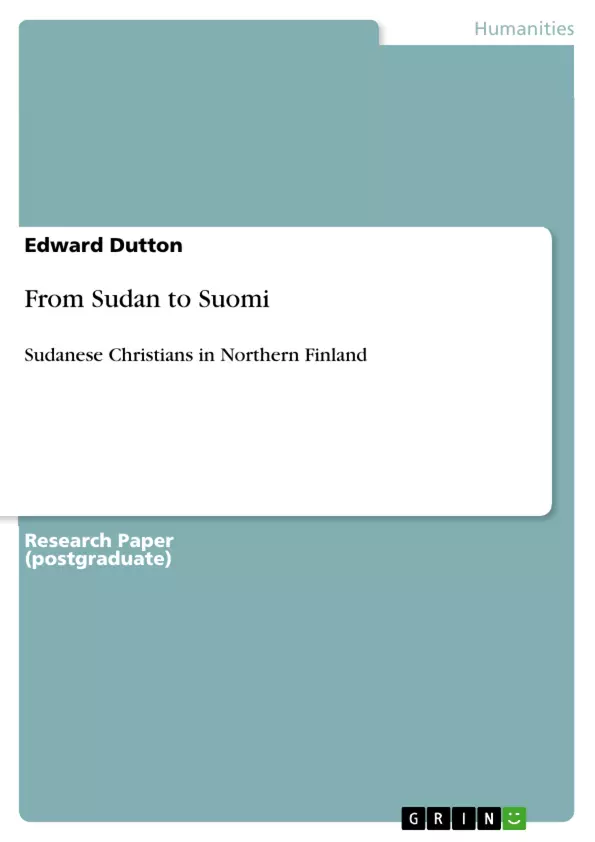ABSTRACT
Sudan and Suomi (‘Finland’ in Finnish) are very different nations. Various assessments have rated Finland the best country in the world in which to live while Sudan struggles, mired in poverty and intermittent civil war. Finland is the world’s most northerly nation state while Sudan lies close to equator. But, despite the many differences, Finland began to accept Southern Sudanese – mostly Christian – refugees in 2001 and they have since established a nationwide Anglican community and various other churches. There is a significantly sized Southern Sudanese community in Oulu, in the north of the country.
From Sudan to Suomi is an ethnographic account of the Southern Sudanese Christian churches in Oulu and the first detailed ethnographic account of any Southern Sudanese community in Finland. Through participant observation, it attempts to gain a deeper understanding of Southern Sudanese religiosity and culture and the way in which Southern Sudanese life has developed in its specifically Finnish cultural context. In doing so, From Sudan to Suomi also aims to help those who work with Sudanese refugees better understand the dynamics and nuances of Southern Sudanese Diaspora culture.
Inhaltsverzeichnis (Table of Contents)
- WINTER IN NORTHERN FINLAND
- THE PROBLEM OF CULTURE
- ANTHROPOLOGY AND DIASPORA
- INITIAL OBSERVATIONS
- THE SUDANESE CHURCHES OF OULU
- SUNDAY AT THE SUDANESE ANGLICAN CHURCH
- LIFE WITHOUT MEANING?
Zielsetzung und Themenschwerpunkte (Objectives and Key Themes)
This book explores the lives and experiences of Sudanese Christian refugees in Oulu, Finland. It aims to provide an ethnographic account of their religious and cultural practices, particularly focusing on the development of Southern Sudanese life within a Finnish cultural context. It also seeks to offer insights to those working with Sudanese refugees, helping them understand the dynamics of Southern Sudanese Diaspora culture.
- The adaptation and integration of Sudanese Christian refugees in Finland.
- The role of religion and cultural practices in the lives of Southern Sudanese refugees.
- The impact of Finnish culture and society on the lives of Southern Sudanese refugees.
- The experiences and perspectives of Sudanese Christians in a new cultural context.
- The challenges and opportunities faced by Southern Sudanese refugees in Finland.
Zusammenfassung der Kapitel (Chapter Summaries)
- Chapter One: Winter in Northern Finland introduces the setting of the study in Oulu, Finland, emphasizing the stark contrast between the harsh Finnish winter and the refugees' prior experiences. It provides a glimpse into the socioeconomic realities of the Oulu suburb where many Sudanese refugees reside.
- Chapter Two: The Problem of Culture delves into the theoretical framework of the study, exploring the concept of culture and its relevance to the study of diaspora communities.
- Chapter Three: Anthropology and Diaspora further examines the theoretical foundations of the study, drawing on anthropological perspectives to understand the phenomenon of diaspora and its implications for the experiences of refugees.
- Chapter Four: Initial Observations offers preliminary observations and insights gained from the researcher's initial encounters with the Sudanese community in Oulu.
- Chapter Five: The Sudanese Churches of Oulu examines the role and significance of churches in the lives of Sudanese refugees, exploring their religious practices and the social connections they provide.
- Chapter Six: Sunday at the Sudanese Anglican Church delves deeper into the specific example of the Sudanese Anglican Church in Oulu, providing a detailed account of a Sunday service and the cultural practices associated with it.
- Chapter Seven: Life Without Meaning? explores themes of meaning, purpose, and identity among Sudanese refugees in Finland, considering the challenges and adaptations associated with adjusting to a new cultural context.
Schlüsselwörter (Keywords)
This research focuses on the themes of cultural adaptation, religious practice, Diaspora studies, Southern Sudanese refugees, and the experiences of marginalized communities within a Finnish context. It explores concepts like cultural identity, religious expression, and the challenges of acculturation, particularly in relation to the lived experiences of Sudanese Christians in Oulu, Finland.
- Quote paper
- Edward Dutton (Author), 2010, From Sudan to Suomi, Munich, GRIN Verlag, https://www.grin.com/document/163098



